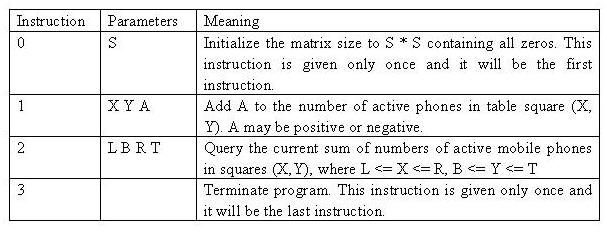POJ 1195.Mobile phones-二维树状数组
| Time Limit: 5000MS | Memory Limit: 65536K | |
| Total Submissions: 20525 | Accepted: 9485 |
Description
Suppose that the fourth generation mobile phone base stations in the Tampere area operate as follows. The area is divided into squares. The squares form an S * S matrix with the rows and columns numbered from 0 to S-1. Each square contains a base station. The number of active mobile phones inside a square can change because a phone is moved from a square to another or a phone is switched on or off. At times, each base station reports the change in the number of active phones to the main base station along with the row and the column of the matrix.
Write a program, which receives these reports and answers queries about the current total number of active mobile phones in any rectangle-shaped area.
Write a program, which receives these reports and answers queries about the current total number of active mobile phones in any rectangle-shaped area.
Input
The input is read from standard input as integers and the answers to the queries are written to standard output as integers. The input is encoded as follows. Each input comes on a separate line, and consists of one instruction integer and a number of parameter integers according to the following table.

The values will always be in range, so there is no need to check them. In particular, if A is negative, it can be assumed that it will not reduce the square value below zero. The indexing starts at 0, e.g. for a table of size 4 * 4, we have 0 <= X <= 3 and 0 <= Y <= 3.
Table size: 1 * 1 <= S * S <= 1024 * 1024
Cell value V at any time: 0 <= V <= 32767
Update amount: -32768 <= A <= 32767
No of instructions in input: 3 <= U <= 60002
Maximum number of phones in the whole table: M= 2^30

The values will always be in range, so there is no need to check them. In particular, if A is negative, it can be assumed that it will not reduce the square value below zero. The indexing starts at 0, e.g. for a table of size 4 * 4, we have 0 <= X <= 3 and 0 <= Y <= 3.
Table size: 1 * 1 <= S * S <= 1024 * 1024
Cell value V at any time: 0 <= V <= 32767
Update amount: -32768 <= A <= 32767
No of instructions in input: 3 <= U <= 60002
Maximum number of phones in the whole table: M= 2^30
Output
Your program should not answer anything to lines with an instruction other than 2. If the instruction is 2, then your program is expected to answer the query by writing the answer as a single line containing a single integer to standard output.
Sample Input
0 4 1 1 2 3 2 0 0 2 2 1 1 1 2 1 1 2 -1 2 1 1 2 3 3
Sample Output
3 4
二维树状数组,和一维没什么太大差别,就是写这个题的时候Runtime Error了好几发,是定义数组大小的时候不能定义的太大,比题目要求的大一点点就可以。
代码:
1 #include<iostream>
2 #include<cstdio>
3 #include<cstring>
4 using namespace std;
5 const int N=2000+10;
6 int num[N][N];
7 int s;
8 int lowbit(int x){
9 return x&(-x);
10 }
11 void add(int x,int y,int val){
12 for(int i=x;i<=s;i+=lowbit(i)){
13 for(int j=y;j<=s;j+=lowbit(j)){
14 num[i][j]+=val;
15 }
16 }
17 }
18 int SUM(int x,int y){
19 int sum=0;
20 for(int i=x;i>0;i-=lowbit(i)){
21 for(int j=y;j>0;j-=lowbit(j)){
22 sum+=num[i][j];
23 }
24 }
25 return sum;
26 }
27 int main(){
28 int t,T;
29 int x,y,a,l,r;
30 scanf("%d%d",&t,&s);
31 memset(num,0,sizeof(num));
32 while(~scanf("%d",&T),T<3){
33 if(T==1){
34 scanf("%d%d%d",&x,&y,&a);
35 x++;
36 y++;
37 add(x,y,a);
38 }
39 else if(T==2){
40 scanf("%d%d%d%d",&x,&y,&l,&r);
41 x++;y++;l++;r++;
42 printf("%d\n",SUM(l,r)-SUM(l,y-1)-SUM(x-1,r)+SUM(x-1,y-1));
43 }
44 }
45 return 0;
46 }
哇,写了一晚上这个博客,朕的千年老腰要断了(꒪Д꒪)ノ
写着写着就眼花了,可能有的地方写错了_(:з」∠)_太菜啦,我怎么这么菜(ಥ_ಥ)





【推荐】编程新体验,更懂你的AI,立即体验豆包MarsCode编程助手
【推荐】凌霞软件回馈社区,博客园 & 1Panel & Halo 联合会员上线
【推荐】抖音旗下AI助手豆包,你的智能百科全书,全免费不限次数
【推荐】博客园社区专享云产品让利特惠,阿里云新客6.5折上折
【推荐】轻量又高性能的 SSH 工具 IShell:AI 加持,快人一步